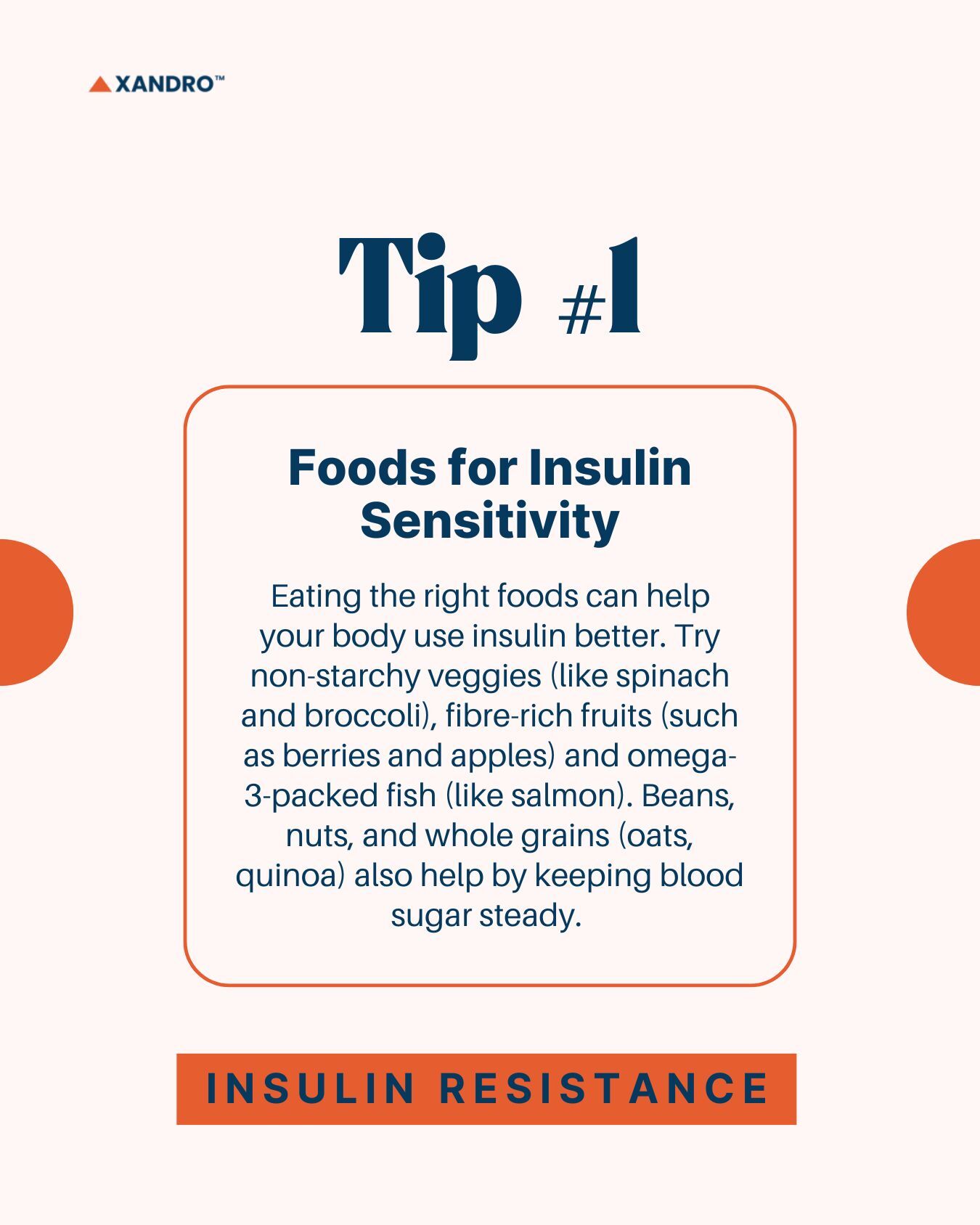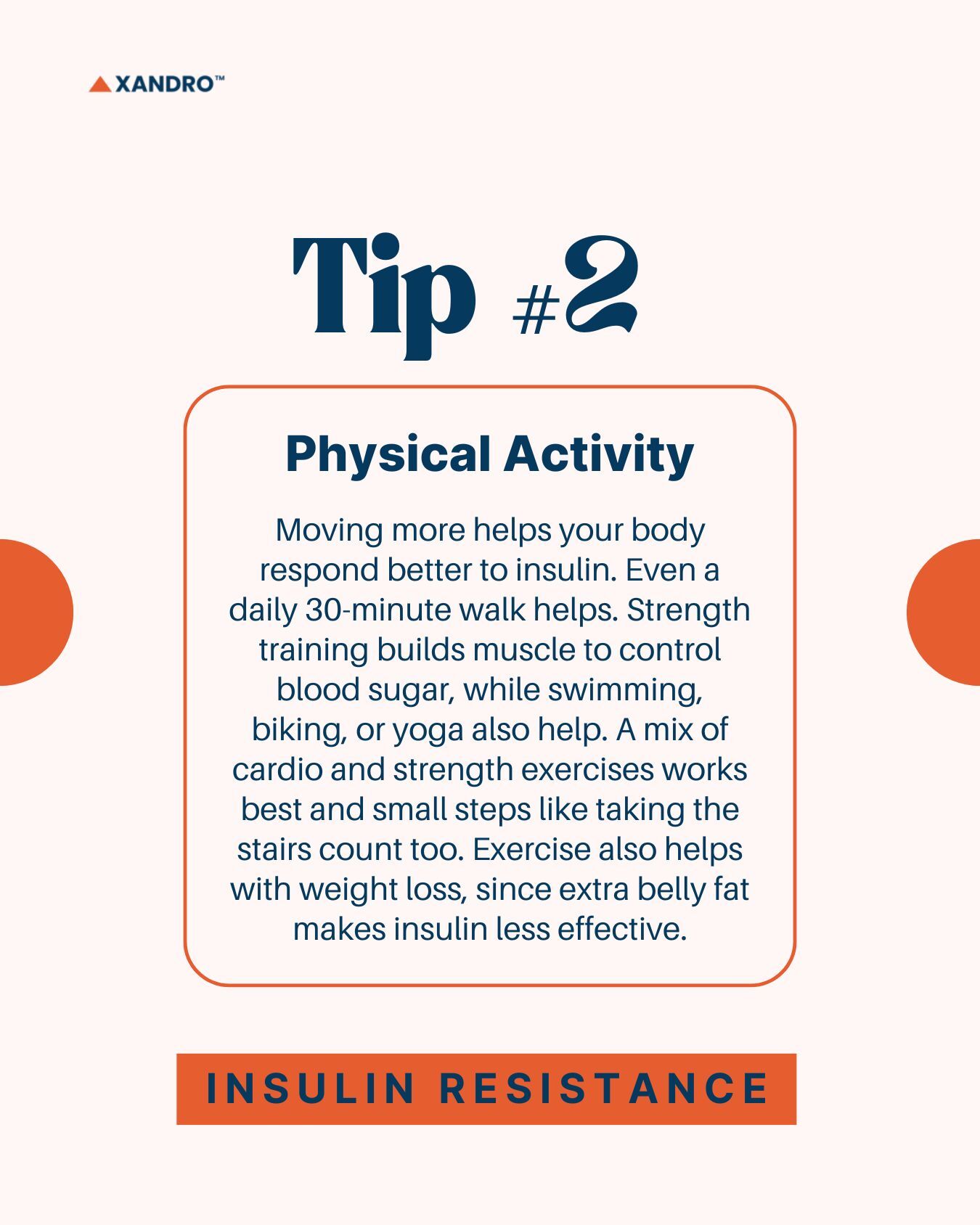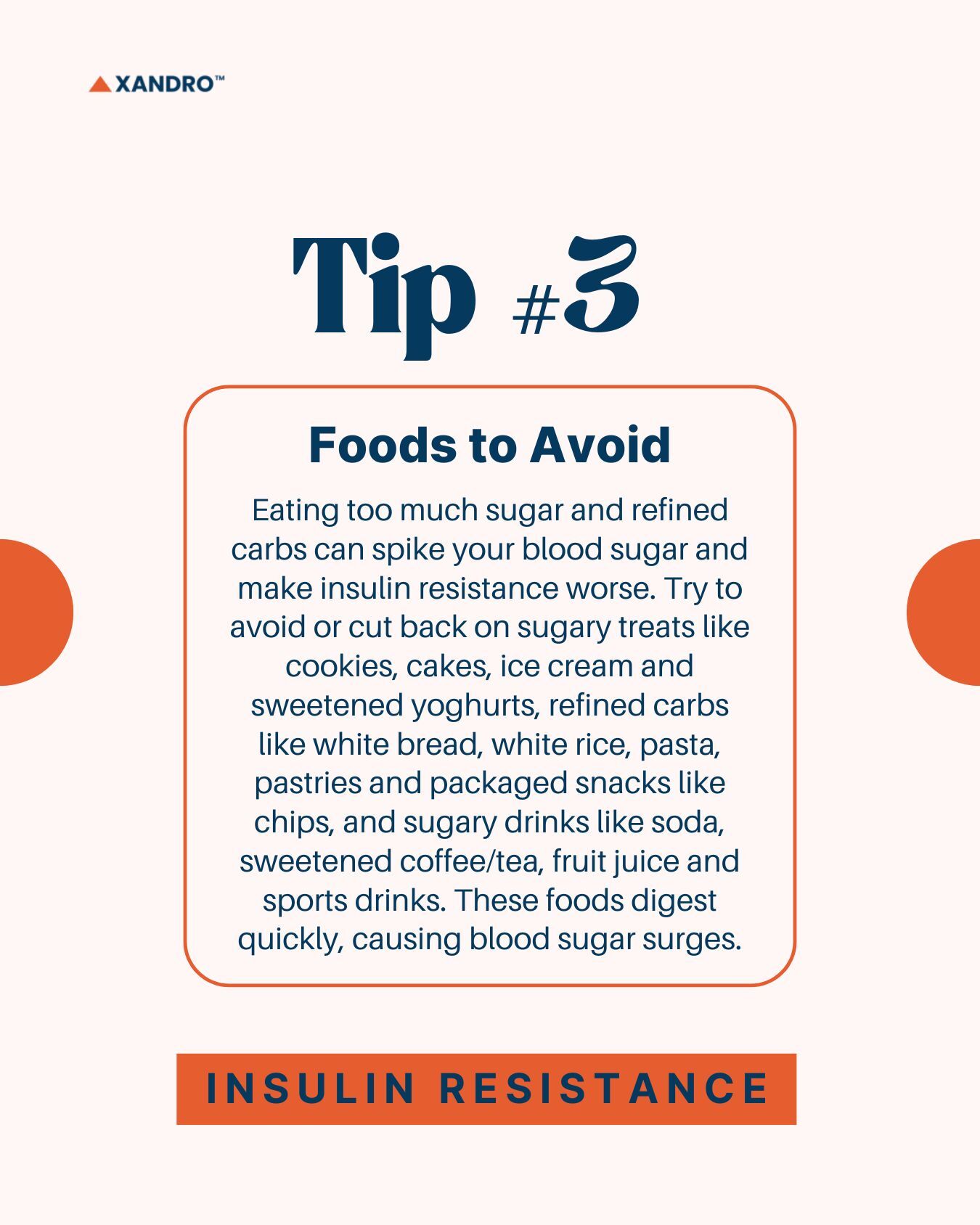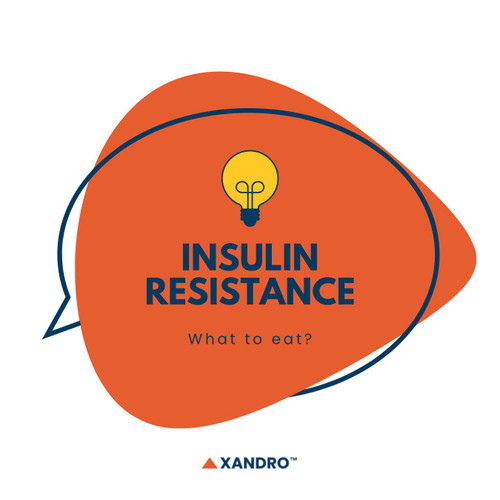What to Eat for Insulin Resistance? | Xandro Lab
3rd Aug 2025
Best Foods for Insulin Resistance & How to Reverse It Naturally
Did you know that in your body, it’s your pancreas that produces insulin?
When your body becomes resistant to insulin, your pancreas has to work harder to keep blood sugar levels stable. Over time, this can lead to diabetes. While you can’t directly control insulin production, certain lifestyle and dietary choices can help support your pancreas and improve insulin sensitivity naturally.
So, if interested in how to increase insulin production in the pancreas naturally, here are some aspects to keep in mind, from the foods you eat (and don’t eat), to lifestyle habits.
See if your country has a diabetes program to help get your health under wraps, like Singapore’s Let’s Beat Diabetes.
Jump there now:
- What to Eat for Insulin Resistance
- What to Eat for Insulin Resistance and PCOS
- Foods That Increase Insulin Production
- How to Reverse Insulin Resistance
- Insulin Resistance Foods to Avoid
What to Eat for Insulin Resistance
Insulin resistance happens when your body’s cells don’t respond well to insulin, making it harder to control blood sugar. The right foods can help improve insulin sensitivity and keep blood sugar stable. While there’s no single perfect diet, focusing on whole, nutrient-rich foods can make a big difference. Vegetables, fruits, lean proteins, whole grains and healthy fats are a must. Avoiding processed foods, sugary drinks and refined carbs also helps, but it’s also important to remember that everyone responds differently to food, so trialling various foods in your diet can help guide you toward the best choices for your body.
Best Foods to Improve Insulin Sensitivity
Certain low insulin producing foods help your body use insulin more effectively.
- Non-starchy vegetables like spinach, broccoli and capsicum are excellent because they’re low in carbs and high in fibre.
- Whole fruits, such as berries, apples and oranges provide natural sugars along with fibre to slow digestion.
- Fatty fish like salmon and sardines offer omega-3s, which support heart health and insulin function.
- Beans, lentils and nuts add protein and fibre, keeping you full without spiking blood sugar.
- Whole grains like oats, quinoa and brown rice digest slowly, helping maintain steady glucose levels.
So, start including these foods regularly to help boost your insulin sensitivity over time.

Balanced Macronutrients for Blood Sugar Control
Carbs, protein and fat all play a role in managing insulin resistance. Carbs have the biggest impact on blood sugar, so choosing high-fibre, slow-digesting options, like whole grains and vegetables, helps prevent spikes.
What’s more, pairing carbs with protein (such as chicken, fish, or tofu) or healthy fats (like avocado or nuts) slows absorption even further. For example, adding almond butter to an apple or eating brown rice with salmon creates a balanced meal. The goal isn’t to cut out carbs completely but to balance them with other nutrients for steady energy and better blood sugar control.
The Role of Fibre in Managing Insulin Resistance
Fibre is great for insulin resistance because it slows digestion and prevents blood sugar spikes. There are two types:
- Soluble fibre (found in oats, beans and apples) forms a gel-like substance that delays sugar absorption.
- Insoluble fibre (in whole grains and vegetables) adds bulk to keep digestion steady.
Eating at least 25–38g of fibre daily from foods like lentils, chia seeds and leafy greens can improve insulin sensitivity. Fibre also feeds beneficial gut bacteria, which research links to better metabolic health. How to do this? Swapping refined grains for whole grains and snacking on nuts instead of chips are simple ways to increase fibre intake.
What to Eat for Insulin Resistance and PCOS
Polycystic ovary syndrome (PCOS) often goes hand-in-hand with insulin resistance, making blood sugar management crucial. Eating for insulin resistance, and the right foods at that, can help regulate hormones, improve insulin sensitivity and reduce PCOS symptoms. Focus on whole, nutrient-dense foods like non-starchy vegetables, lean proteins and high-fibre options. Avoiding processed sugars and refined carbs is important, as they worsen insulin resistance. Since PCOS affects metabolism and hormones uniquely, a diet that’s personal to you can you help identify the best foods for your body.
Best Low-Glycaemic Foods for PCOS
Low-glycaemic (low-GI) foods digest slowly, preventing blood sugar spikes that worsen insulin resistance. Choosing the below foods helps manage PCOS symptoms while keeping energy levels stable:
- Non-starchy vegetables, such as spinach, broccoli and capsicum, are excellent low-GI choices.
- Whole fruits like berries, apples and citrus provide natural sugars with fibre to slow absorption.
- Whole grains such as quinoa, barley and steel-cut oats offer steady energy.
- Legumes like lentils and chickpeas combine fibre and protein for balanced blood sugar.
- Nuts and seeds provide healthy fats and minimal carb impact.
Foods That Increase Insulin Production
The right foods can help your body produce insulin more effectively, keeping blood sugar balanced. While no single food directly boosts insulin production, certain nutrients support pancreatic function and improve insulin sensitivity.
Focus on whole foods rich in fibre, healthy fats and quality proteins. These nutrients work together to help your body manage blood sugar naturally. The key is choosing foods that promote steady insulin release rather than sudden spikes.
Natural Foods That Stimulate Insulin Secretion
Some foods naturally encourage insulin release by supporting pancreatic health. For example:
- Cinnamon contains compounds that may improve insulin sensitivity.
- Fenugreek seeds are rich in soluble fibre and may help regulate blood sugar.
- Apple cider vinegar before meals may improve insulin response.
- Turmeric contains curcumin, which supports pancreatic function.
- Green tea provides antioxidants that help with glucose metabolism.
These foods work best when combined with a balanced diet of whole grains, lean proteins and healthy fats.
Many diabetics take metformin, but does it have any other health benefits? Read here.
How to Reverse Insulin Resistance
Now that you know about dietary changes that improve insulin sensitivity, what are some other lifestyle changes that may help?
While eating the right foods is important, combining nutrition with other lifestyle adjustments creates the most effective approach. Regular physical activity, quality sleep, stress management and maintaining a healthy weight all work together to improve insulin sensitivity.
Small, consistent changes in these areas can help your body respond better to insulin over time, so try to create sustainable habits that support metabolic health long-term.
The Importance of Regular Physical Activity
Movement directly improves insulin sensitivity by helping your muscles use glucose more efficiently. Even walking for just 30 minutes daily can make a significant difference. What’s more, strength training builds muscle mass, which naturally helps regulate blood sugar, while activities like swimming, cycling, or yoga also contribute to better insulin function.
The best approach combines both cardio and resistance exercises several times per week. Even simple changes like taking the stairs or standing more during the day add up. Doing this can also help you lose weight, which is important as excess body fat, especially around the abdomen, increases inflammation and makes cells less responsive to insulin. Losing even 5–10 per cent of your body weight can significantly improve insulin sensitivity, easing the burden on your pancreas.

Sleep and Its Role in Metabolic Health
Quality sleep is a must for maintaining proper insulin sensitivity. When you don't get enough rest, your body produces more stress hormones that can worsen insulin resistance.
Try to get 7–9 hours of uninterrupted sleep each night. Establishing a regular sleep schedule helps regulate your circadian rhythm, which controls many metabolic processes. For example, creating a dark, cool sleeping environment and limiting screen time before bed can improve sleep quality.
What’s more, poor sleep is linked to increased hunger hormones and cravings for sugary foods, making good rest an important part of managing insulin resistance. Addressing sleep issues like apnoea may also help improve metabolic function.
You can also try taking supplements, once you’ve spoken with your doctor. We’ve written about some in our Diabetes Supplements Guide.
You can also learn how supplements like Shoden® Ashwagandha can help with sleep, as well as the benefits of magnesium on sleep by taking Magnesium Glycinate 500mg.
Insulin Resistance Foods to Avoid
If you have insulin resistance, certain foods can make it harder for your body to manage blood sugar levels. To refresh, insulin is a hormone that helps your cells absorb glucose (sugar) from your bloodstream. When your cells stop responding properly to insulin, your blood sugar stays high, increasing your risk of diabetes. By avoiding certain foods, you can help your body become more sensitive to insulin.
High-Sugar Foods That Worsen Insulin Resistance
Foods high in added sugar cause rapid spikes in blood sugar, forcing your body to produce more insulin. Over time, this can make insulin resistance worse. Avoid or limit:
- Candy, cookies, cakes and pastries
- Ice cream and sweetened desserts
- Breakfast cereals with added sugar
- Flavoured yoghurts with high sugar content
Refined Carbs and Processed Foods to Eliminate
Refined carbohydrates are stripped of fibre, causing quick digestion and blood sugar surges. Processed foods often contain unhealthy fats and additives that contribute to insulin resistance. Cut back on:
- White bread, white rice and white pasta
- Pastries, muffins and doughnuts
- Packaged snacks like chips and crackers
- Instant noodles and processed meal kits
Sugary Beverages and Their Impact on Insulin Levels
Liquid sugar is especially harmful because it’s absorbed quickly, leading to sharp rises in blood sugar and insulin. Replace these drinks with water, herbal tea, or unsweetened options:
- Soda and energy drinks
- Sweetened coffee and tea beverages
- Fruit juices (even 100 per cent juice can be high in sugar)
- Sports drinks and flavoured vitamin waters

End Note
By focusing on these food principles, you can take meaningful steps toward better insulin sensitivity and long-term health. Small, consistent changes, like adding more vegetables or choosing whole grains, add up over time.
